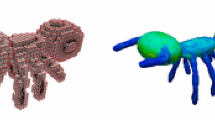Abstract
The question of contour uniformity on a three-dimensional surface arises in various fields of study. Although many questions related to surface uniformity exist, there is a lack of standard methodology to quantify uniformity of a three-dimensional surface. Therefore, a sound mathematical approach to this question could prove to be useful in various areas of study. The purpose of this paper is to expand the previously validated mathematical concept of the inverse maximum ratio over a three-dimensional surface and assess its robustness. We will describe the mathematical approach used to accomplish this and use several simulated examples to validate the metric.










Similar content being viewed by others
Notes
In this and later examples the vertical coordinate (dimension), z, is relative to a planar surface defined by the coordinates x and y. This allows us to directly relate results to our previous 2-dimensional analysis [2]. In the Discussion section, we will address the issue of spherical coordinates.
References
Bünnagel, R., Oehring, H. A., & Steiner, K. (1968). Fizeau interferometer for measuring the flatness of optical surfaces. Applied Optics, 7(2), 331–335.
Chandran, A., Brown, D., Danoff, J., & DiPietro, L. (2015). Using the inverse maximum ratio-Λ as a technique to quantify surface uniformity. Communications in Statistics Simulation and Computation, 45(1), 1–14.
Di Lelio, A., Cestari, C., Lomazzi, A., & Beretta, L. (1989). Cirrhosis: Diagnosis with sonographic study of the liver surface. Radiology, 172(2), 389–392.
Gao, W., Huang, P. S., Yamada, T., & Kiyono, S. (2002). A compact and sensitive two-dimensional angle probe for flatness measurement of large silicon wafers. Precision Engineering, 26(4), 396–404.
Gu, F., Melkote, S. N., Kapoor, S. G., & DeVor, R. E. (1997). A model for the prediction of surface flatness in face milling. Journal of Manufacturing Science and Engineering, 119(4A), 476–484.
Jiang*, B. C., Wang, C. C., & Liu, H. C. (2005). Liquid crystal display surface uniformity defect inspection using analysis of variance and exponentially weighted moving average techniques. International Journal of Production Research, 43(1), 67–80.
MATLAB Release. (2014). The MathWorks, Inc., Natick. Retrieved from www.mathworks.com/.
Mills, G., Gordon, M. S., & Metiu, H. (2003). Oxygen adsorption on Au clusters and a rough Au (111) surface: The role of surface flatness, electron confinement, excess electrons, and band gap. The Journal of Chemical Physics, 118(9), 4198–4205.
Netto, M. V., Mohan, R. R., Sinha, S., Sharma, A., Dupps, W., & Wilson, S. E. (2006). Stromal haze, myofibroblasts, and surface irregularity after PRK. Experimental Eye Research, 82(5), 788–797.
Prabhakaran, S., Rundek, T., Ramas, R., Elkind, M. S., Paik, M. C., Boden-Albala, B., & Sacco, R. L. (2006). Carotid plaque surface irregularity predicts ischemic stroke the northern manhattan study. Stroke, 37(11), 2696–2701.
Science Photo Library. Retrieved September 1, 2015, from http://www.sciencephoto.com/media/542902/view.
SigmaPlot version 12.3, from Systat Software Inc., San Jose California. Retrieved from www.sigmaplot.com.
Sinha, S., Luo, J., & Chiang, C. (2007). Model based layout pattern dependent metal filling algorithm for improved chip surface uniformity in the copper process. In Design Automation Conference, 2007. ASP-DAC’07. Asia and South Pacific (pp. 1–6). IEEE.
Toksvig-Larsen, S., & Ryd, L. (1991). Surface flatness after bone cutting: A cadaver study of tibial condyles. Acta Orthopaedica, 62(1), 15–18.
Torras, C., & Garcia-Valls, R. (2004). Quantification of membrane morphology by interpretation of scanning electron microscopy images. Journal of Membrane Science, 233(1–2), 119–127.
Tyagi, N. K. (1984). Effect of land surface uniformity on some economic parameters of irrigation in sodic soils under reclamation. Irrigation Science, 5(3), 151–160.
Author information
Authors and Affiliations
Corresponding author
Additional information
Avinash Chandran and Derek Brown have contributed equally in manuscript preparation.
Rights and permissions
About this article
Cite this article
Chandran, A., Brown, D., DiPietro, L. et al. Applying the Inverse Maximum Ratio-Λ to 3-Dimensional Surfaces. 3D Res 7, 15 (2016). https://doi.org/10.1007/s13319-016-0094-7
Received:
Revised:
Accepted:
Published:
DOI: https://doi.org/10.1007/s13319-016-0094-7




